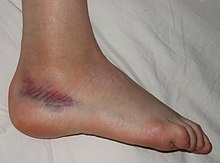| Sprain | |
|---|---|
| Other names | Torn ligament, distorsion |
 | |
| A sprained ankle with bruising and swelling | |
| Specialty | Sports medicine, physical medicine & rehabilitation, orthopedics, family medicine, emergency medicine |
| Symptoms | Pain, swelling, bruising, joint instability, limited range of motion of the injured joint |
| Duration | Mild cases - few days to six weeks
Severe cases - few weeks to months |
| Causes | Trauma, sports injuries, overuse, environmental hazards |
| Risk factors | Environmental factors, age, poor training or sports gear |
| Diagnostic method | Physical exam, joint x-ray |
| Differential diagnosis | Strain, fracture |
| Prevention | Frequent stretching and conditioning, bracing at risk joints during exercise |
| Treatment | Rest, ice, compression, elevation, NSAIDs |
| Medication | Non-steroidal anti-inflammatory drugs (NSAIDs) |
| Prognosis | Mild injuries resolve well on their own.
Severe injuries likely require surgery and physical therapy. |
A sprain is a soft tissue injury of the ligaments within a joint, often caused by a sudden movement abruptly forcing the joint to exceed its functional range of motion. Ligaments are tough, inelastic fibers made of collagen that connect two or more bones to form a joint and are important for joint stability and proprioception, which is the body's sense of limb position and movement.[1] Sprains may be mild (first degree), moderate (second degree), or severe (third degree), with the latter two classes involving some degree of tearing of the ligament. Sprains can occur at any joint but most commonly occur in the ankle, knee, or wrist.[2] An equivalent injury to a muscle or tendon is known as a strain.
The majority of sprains are mild, causing minor swelling and bruising that can be resolved with conservative treatment, typically summarized as RICE: rest, ice, compression, elevation. However, severe sprains involve complete tears, ruptures, or avulsion fractures, often leading to joint instability, severe pain, and decreased functional ability. These sprains require surgical fixation, prolonged immobilization, and physical therapy.[3]
- ^ Bahr, Roald; Alfredson, Håkan; Järvinen, Markku; Järvinen, Tero; Khan, Karim; Kjaer, Michael; Matheson, Gordon; Maehlum, Sverre (2012-06-22), Bahr, Roald (ed.), "Types and Causes of Injuries", The IOC Manual of Sports Injuries, Wiley-Blackwell, pp. 1–24, doi:10.1002/9781118467947.ch1, ISBN 978-1-118-46794-7
- ^ Hartshorne, Henry. "Sprained Joints". The Home Cyclopedia Of Health And Medicine. Retrieved 16 February 2010.
- ^ "Ligament Sprain". Physiopedia. Retrieved 2020-04-13.